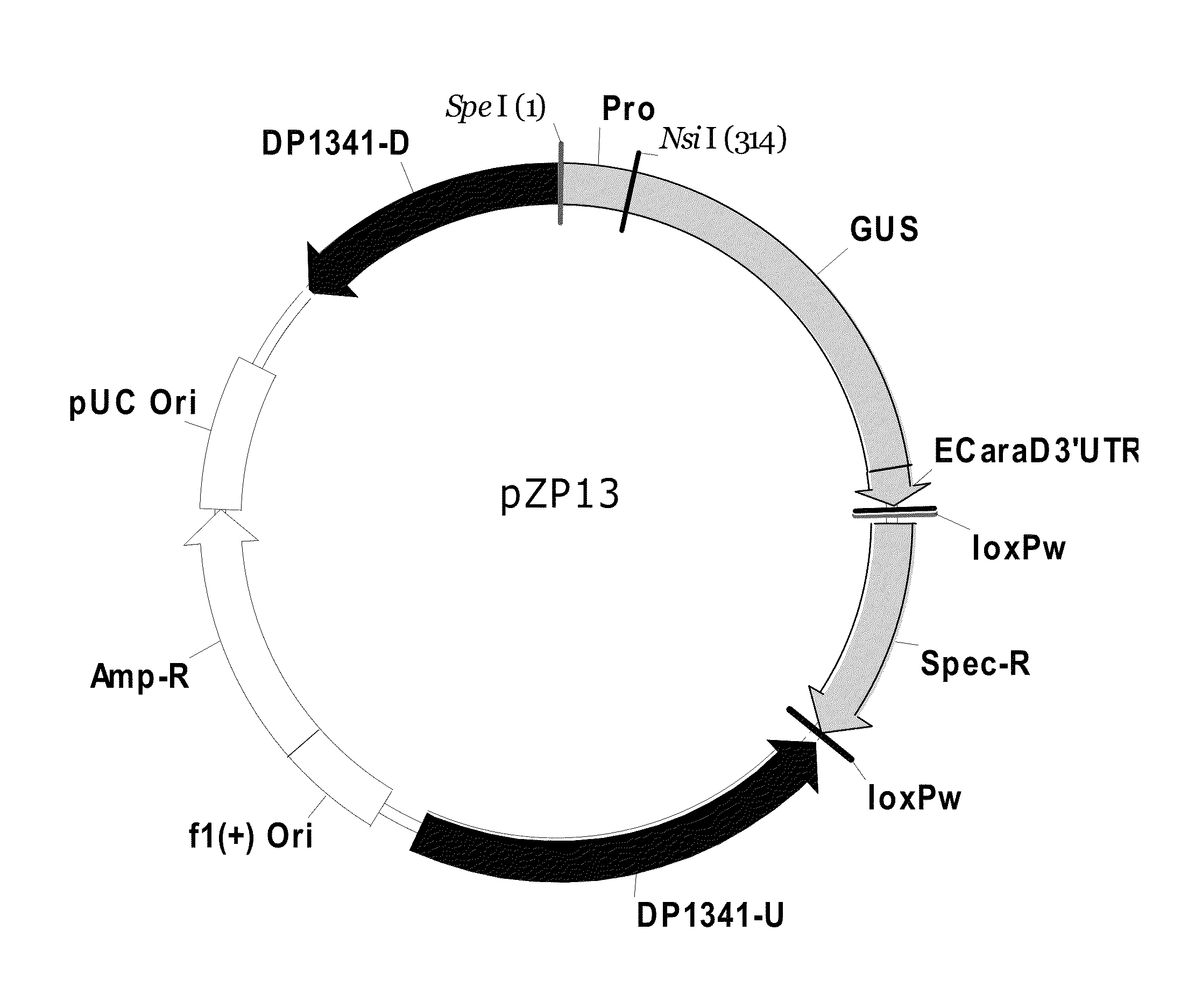High expression Zymomonas promoters
a technology of promoters and zymomonas, which is applied in the field of microbiology and genetic engineering, can solve the problems of engineered strains not growing and producing ethanol, and achieve the effect of improving activity
- Summary
- Abstract
- Description
- Claims
- Application Information
AI Technical Summary
Benefits of technology
Problems solved by technology
Method used
Image
Examples
example 1
Construction of Promoter-GUS Test Integration Vectors
[0079]For integration of DNA in the Zymomonas mobilis genome, the pZP13 Double Cross Over (DCO) suicide vector was constructed. FIG. 1 shows its schematic map. This plasmid has a pBluescript backbone, containing an E. coli replication site but no Z. mobilis replication site. Therefore, it cannot be propagated in Z. mobilis. Two fragments in pZP13 that target genomic recombination, DP1341-U and DP1341-D, were synthesized from Z. mobilis genomic DNA by PCR. Sequences referred to are in the Z. mobilis genome sequence: Seo et al. (2005) Nat. Biotechnol. 23:63-68; NCBI Reference: NC—006526.2). The 1,951-bp DP1341-U fragment (SEQ ID NO:8) includes the first 217 bp (from nt-1 to nt-217) of the ZMO1250 coding sequence and 1,734-bp of upstream sequence. The 1,255-bp DP1341-D fragment (SEQ ID NO:9) includes the last 704 bp (from nt-218 to nt-921) of the ZMO1250 coding sequence and 551-bp of downstream sequence. These two fragments direct in...
example 2
Integration of Promoter-GUS Expression Cassettes
[0082]The test promoter-GUS chimeric genes were integrated into the genome of the wild type Z. mobilis strain ZW1 (ATCC #31821). Competent cells were prepared by growing ZW1 overnight in MRM3G5 (1% yeast extract, 15 mM KH2PO4, 4 mM MgSO4, and 50 g / L glucose) at 30° C. with 150 rpm shaking. The OD600 value was measured using a Shimadzu UV-1200 Spectrophotometer (Kyoto, Japan). Cells were harvested and resuspended in fresh medium to an OD600 value of 0.05. Cells were grown under the same conditions to early-middle log phase (OD600 near 0.5), then harvested and washed twice with ice-cold water and once with ice-cold 10% glycerol. The resulting competent cells were collected and resuspended in ice-cold 10% glycerol to an OD600 value near 100. Since transformation of Z. mobilis requires non-methylated DNA, pZP1332 and pZP1337 were first transformed into E. coli SCS110 competent cells (Stratagene, La Jolla, Calif.). For each transformation, ...
example 3
Promoter Comparison by GUS Activity Assay
[0084]To measure GUS activity, two transformants containing ZW1-ZP1332 (ZW1-ZP1332 #11 and #12) or ZW1-ZP1337 (ZW1-ZP1337 #1 and #8) were grown overnight in 2 mL MRM3G5-Spec200 at 30° C. with 150 rpm shaking. Then 50 μL cultures were added into 5 mL fresh MRM3G5-Spec200 and grown 16 hrs at 30° C. with 150 rpm shaking in a 14 mL capped Falcon tube, until OD600 was near 6. Cells were collected by centrifuge, washed with 1 mL GUS assay base buffer (50 mM NaPO4 buffer, pH7.0, 1 mM EDTA) twice, resuspended in 1 mL protein extract buffer (GUS assay base buffer containing 5% glycerol). Each cell suspension was placed in a BIO101 2 mL capped tube containing Lysing Matrix A beads (BIO101, La Jolla, Calif.) and shaken 3 times on a BIO101 Fastprep FP1200 at Step 5 for 20 second. Cell debris and beads were spun down in a micro-centrifuge, and the supernatant was collected as protein extract.
[0085]Protein concentration in the extract was determined using ...
PUM
| Property | Measurement | Unit |
|---|---|---|
| pH | aaaaa | aaaaa |
| pH | aaaaa | aaaaa |
| nucleic acid | aaaaa | aaaaa |
Abstract
Description
Claims
Application Information
 Login to View More
Login to View More - R&D
- Intellectual Property
- Life Sciences
- Materials
- Tech Scout
- Unparalleled Data Quality
- Higher Quality Content
- 60% Fewer Hallucinations
Browse by: Latest US Patents, China's latest patents, Technical Efficacy Thesaurus, Application Domain, Technology Topic, Popular Technical Reports.
© 2025 PatSnap. All rights reserved.Legal|Privacy policy|Modern Slavery Act Transparency Statement|Sitemap|About US| Contact US: help@patsnap.com

